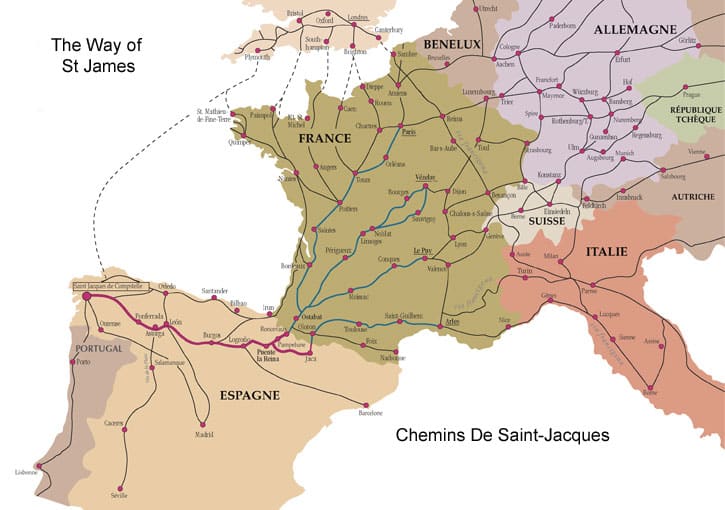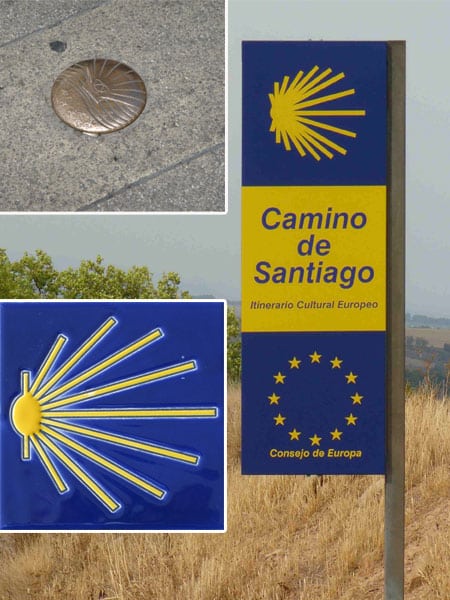Emerging in medieval times, the Way of St. James (El Camino de Santiago) is an excursion of nearly 800 kilometres across Northern Spain in order to arrive at the Cathedral of Santiago de Compostela, where many believe the remains of Saint James lie. There are many locations to begin the journey apart from that of Spain, throughout Europe and even within North Africa, which partially explains the use of a scallop shell to symbolize the pilgrimage. Some believe that El Camino de Santiago provides a form of absolution of sin and penance, but even the non-religious may partake and enjoy.  Although originally the Way of St. James served as a trade route to the Atlantic, it now represents a religious pilgrimage highly popularized by international attention and reverence. People from across the globe partake in the Way of St. James, making it a culturally diverse and significant site; UNESCO named El Camino de Santiago as a World Heritage Site, and ever since it has represented a journey of heritage and accomplishment. Today, devout Christians and tourists alike, numbering in the tens of thousands, hike and/or cycle this route for cultural reflection, personal enjoyment, or for the challenging nature of the endeavour.
Although originally the Way of St. James served as a trade route to the Atlantic, it now represents a religious pilgrimage highly popularized by international attention and reverence. People from across the globe partake in the Way of St. James, making it a culturally diverse and significant site; UNESCO named El Camino de Santiago as a World Heritage Site, and ever since it has represented a journey of heritage and accomplishment. Today, devout Christians and tourists alike, numbering in the tens of thousands, hike and/or cycle this route for cultural reflection, personal enjoyment, or for the challenging nature of the endeavour.
Between the 8th and 12th centuries, the Way of St. James was organized primarily in religious context. Pope Calixtus II is named as responsible for the rise in popularity through his Codex, which writings of are still used in guidebooks of the route. Many original pilgrims were French, and as such those routes were explicitly protected by the Kingdom of France. As more people began to make the journey, hostels and other forms of
Different types of Scallop Shell Markers

accommodation for pilgrims was somewhat industrialized by the Spanish crown. Many pilgrims were given accommodations through churches, such as free meals or places of rest and reflection, and made the journey much more affordable for those who could not pay for the profiteering accommodations established by Spanish royalty. Much of the architecture established along the route during this time still remains today, in conjunction with the traditions and culture that developed as a result of El Camino de Santiago. This allowed for the route to become tourist-like in nature, and now travellers can purchase souvenirs and other products to commemorate their experience. One of these souvenirs is a scallop shell, which one can tie to their backpack or belongings as a symbol of their sacrifice and alliance with the history attached to the route.
The scallop shell has become an archetypal symbol for the Way of St. James because of legend and also the metaphor of the journey as it has developed over the past millennia. Found on the coast of Galicia, the shell serves culturally as a reminder of the history of the route as well as a tradition for those partaking in the journey. As legend has it, St. James’ body washed up on the Galician coast protectively covered in scallop shells, which is the origin of the symbol of El Camino de Santiago. Pilgrims would wear the shell as a symbol of devotion to the journey in hopes of safe passage, which is argued to have warded off thieves and provided tangible safety for the travellers. More so, the shell metaphorically represents the many different places one might embark on the journey from, but all roads lead to one solitary point at the base of the shell. Historians also say that scallop shells were very practical for pilgrims to carry in that they served as a bowl for eating or drinking. Either way, scallop shells are highly significant to the journey aesthetically, and travellers today demonstrate their accomplishment and commitment by displaying a shell on their backpacks or their person.
Originally the Way of St. James was longer than 750 km, although most modern-day participants travel at least 300 km during their trek. Its popularity has sky rocketed since the 1980’s, and even a number of Popes have made the passage. There are many places that one can begin this journey, and for many it is considered to start at one’s home, and end at the Cathedral of Santiago de Compostela. Today, those desiring to embark on El Camino de Santiago must first obtain a Pilgrim’s Passport, which may be purchased through a church or tourist agency. These passports grant cheap and sometimes free accommodations including meals and overnight stay at many hostels and monasteries. Within the passport, the traveller receives stamps to mark their distance travelled along the Way. After walking at least 100 km or cycling 200 km, a modern-day pilgrim can receive a compostela, which is essentially a certificate of completion for the Way of St. James. Upon arriving at the Cathedral, one could attend Pilgrim’s Mass which is held there at noon daily for travellers; though Catholic by nature, this part of the experience represents accomplishment and reverence for those who made the journey, in which even the non-religious can enjoy participation.
Overall, the Way of St. James has provided both a tourist getaway as well as religious source of reverence for hundreds of thousands of people. Though no easy feat, El Camino de Santiago represents a sacrifice of personal endeavour that is much more significant that merely one of religion – it has granted personal reflection for countless individuals and has served as a road of personal discovery for many. It takes the average traveller about three weeks to complete the route, and although thousands are able to accomplish it, the adventure may not be for the faint-hearted (or footed). Over one hundred thousand people each year since the 2000’s have accomplished this remarkable journey, and it stands as one of the world’s most culturally renowned sites. The incredible amount of physical endurance and motivation a traveller must possess to complete the Way of St. James is arguably outweighed by the physical beauty of the route; additionally, the historical passage through Spain has connected numerous cultures throughout the ages. It is highly encouraged that tourists, environmental enthusiasts, and devout Christians alike partake in the adventure of El Camino de Santiago as a means of self-realization and personal spirituality; additionally, it is an affordable way to enjoy cultural heritage and majesty of Northern Spain.
